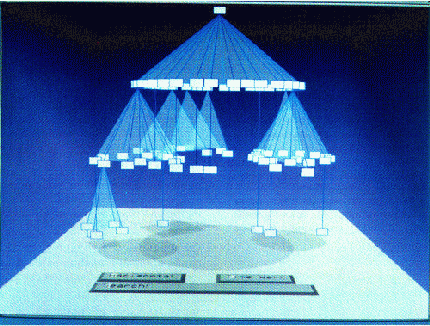Ying-Huey Fua
yingfua@cs.wpi.edu
Ying-Huey Fua
yingfua@cs.wpi.edu
Information visualization allows users to extract knowledge and ultimately extrapolation of that knowledge to find insights. There are many research efforts in information visualization directed at visualizing specific types of information such as hierarchies, networks and graphs. I shall describe the following three techniques that are targeted on visualization of hierarchical information structure especially large hierarchies:
Tree-Maps
The tree-map is a two-dimensional visualization technique for displaying
large amounts of hierarchically structured information [1]. According to
the authors, the original motivation for tree-maps is to have a better
representation of the utilization of disk space where there are multiple
levels of directory levels and nested sub-directories and files. Their
goal is to display the entire set of files hoping that this will allow
users to quickly recognize large files as candidates for deletion when
the disk is full.
A tree-map is formed by taking a rectangular display area and recursively subdividing it based on the tree structure, alternating between horizontal and vertical subdivision, and filling the terminal rectangular regions with a color based on the dependent variable. Figure 1 shows a simple tree structure with its corresponding tree-map. In this case the amount of disk usage (indicated by the number beside each node) determines the size of the partition. The larger the disk usage, the greater the partition. Moreover, each partition is colored based on their file types. In this case, they are all identified as text files, evident from the greenish color.


Figure 1 (http://www.chesapeake2.com/cvj/itorms/treemaps.html)
Directory structures, stock portfolio and companies' organization charts are some of the common applications of tree-maps.
Cone Trees
The cone tree [2,3] is a three-dimensional representation of hierarchical information. The hierarchy is presented in 3D to maximise effective use of available screen space and enable visualization of the whole structure [2,3]. The node of the tree is located at the apex of the cone and all its children are arranged around the circular base of the cone in 3D. Moreover, any node can be brought to the front by clicking on it and rotating the tree.
Figure 2 shows a snapshot of a cone tree. The root of the hierarchy is placed at the top with its children placed evenly spaced along its base. This placement is repeated for each node of the tree, the parent being placed at the apex of the cone. Each cone is shaded transparently so that it can be perceived yet not block the view of cones behind it.

Figure 2 ([2], pg.193)
Common applications of the cone tree includes representation of directory structures, organizational charts and companies' operating plans.
Reconfigurable Disc Trees
Reconfigurable Disc Trees (RDT) [4] is an extension or improvement to the cone tree approach for visualizing information hierarchical structure. RDT has two key information associated with each cone: a reference point and an apex point. The reference point is a node above the center point on the plane of the parent node. The apex node is the top of the cone. Different tree shapes can then be created by changing the distance between the parent node, reference point, apex node and center point of a cone base. By varying these distances, the cone can be flattened out and become a disc, thus making more effective use of screen space. With this feature, more nodes can be visualized before visual clutter sets in.
Figure 3 shows the configurations available in the RDT.


Figure 3 ([3], Color Plates)
Comparisons and Summary
In general, all 3 techniques succeed in visualizing hierarchical information structure more efficiently than the traditional way of visualizing tree structure which is a rooted directed or non-directed graph with the root node at the top and the children nodes below the parent nodes with lines connecting them.
The following table is a simple comparison among the three techniques.
|
|
|
|
| 2D, simple | 3D | 2D or 3D |
| Visual clutter for large hierarchies | Visual clutter for hierarchies > 1000 nodes | Can handle more nodes than cone trees |
| Cannot avoid overlaps when projected to 2D | Can handle overlap for 2D projection |
All three techniques provide some form of interactions such as selection and displaying of a node's information. More elaborate interactions such as pruning and growing of certain sub-structures of the tree or drag-and-drop operations to manipulate the tree structures are available in cone trees and RDT systems.
References
[1] Tree Visualization with Tree-Maps: 2-d Space-Filling Approach
B. Shneiderman. ACM Transactions on Graphics, Vol. 11(1) Jan. '92,
p. 92-99
[2] Cone Trees: Animated 3D Visualizations of Hierarchical Information
G. Robertson, J. Mackinlay, S. Card. Proc. of ACM SIGCHI conference
on Human Factors in Computing Systems '91, p. 189-194
[3] Research Report: Interacting with Huge Hierarchies: Beyond Cone
Trees
J. Carriere, R. Kazman. Proc. of Information Visualization '95,
p. 74-81
[4] Reconfigurable Disc Trees for Visualizing Large Hierarchical Information
Space
C. Jeong, A. Pang. Proc. of Information Visualization '98, p. 19-25